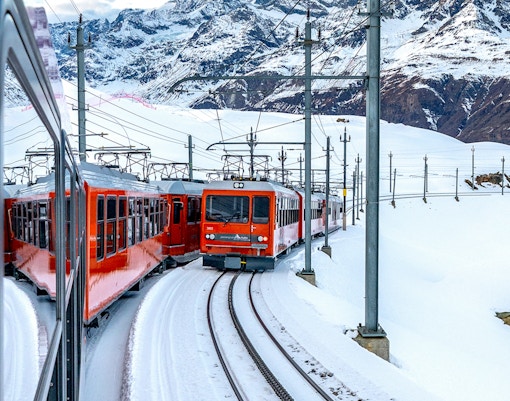- Average temperature: -5°C (23°F)
- Warmest month: June
- Coldest month: February
- Wettest month: June
- Windiest month: January
- Altitude: 3,135 m
- Maximum wind speed: 146 km/h
Gornergrat, perched at 3,135 m, comes with a dynamic weather experience. It swiftly shifts from serene blue skies to dense fog, making each moment unique. Winter brings chilly temperatures plunging to -10°C, while summer arrives with a more pleasant climate, reaching up to 15°C. So, before you head to this beautiful Swiss peak, it’s a good idea to know what the weather is like.














Round-Trip Train Tickets to Mount Gornergrat from Zermatt
From Zermatt: Matterhorn Glacier Paradise Round-Trip Cable Car Tickets + Gornergrat Round-Trip Train Tickets
Round-Trip Train Tickets to Gornergrat from Zermatt + Zermatt Shuttle Tickets
Round-Trip Train Tickets to Mount Gornergrat from Zermatt + Glacier Express: Panoramic Train between Zermatt, Chur and St. Moritz
Swiss Travel Continuous Pass: Unlimited Travel on Train, Bus & Boat
Yes, the temperature at Gornergrat can fluctuate noticeably between day and night. During sunny days, temperatures can rise above freezing, especially in summer. However, after sunset, temperatures often drop rapidly due to the high altitude and lack of cloud cover.
Generally, Gornergrat tends to be cooler than Zermatt due to its higher elevation. The temperature difference can range from 5°C to 10°C (9°F to 18°F) depending on the time of year and weather conditions.
It is advisable to dress in layers when visiting Gornergrat. Even in summer, temperatures can be chilly, especially in early mornings and late evenings. A warm jacket, hat, gloves, and sturdy shoes are recommended. In winter, additional thermal layers, a scarf, and snow boots are necessary.
Yes, weather conditions at Gornergrat, including fog, rain, and snow, can impact visibility. Clear days offer views of the Matterhorn and surrounding peaks, while cloudy or stormy weather may limit visibility. It's advisable to check the weather forecast before planning your visit for the best experience.
Weather conditions at Gornergrat can greatly influence outdoor activities. During clear weather, hiking, skiing, and sightseeing are popular and enjoyable. However, adverse weather like snow or strong winds can limit outdoor activities, requiring adjustments in plans or even temporary closures of certain attractions and trails.
Snowfall is common at Gornergrat, especially during the winter months from December to March. The area receives significant snow accumulation, creating ideal conditions for winter sports and offering picturesque snowy landscapes.












